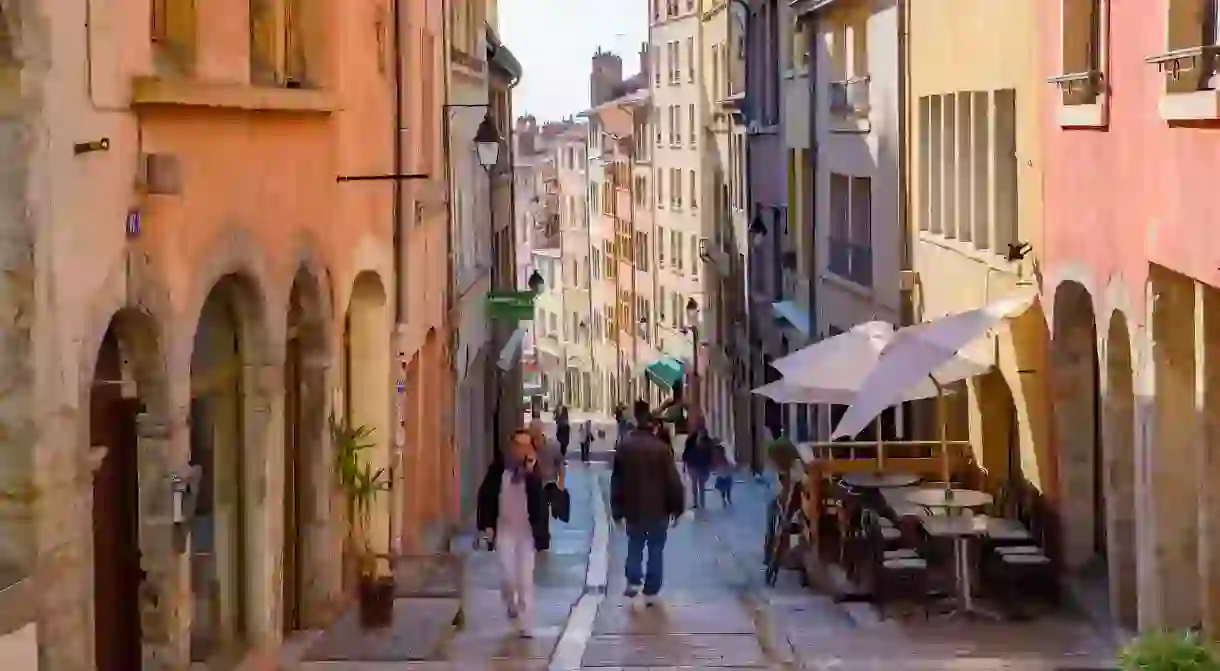Getting Around Lyon With Limited Mobility

For a city that is known for its winding cobbled streets and narrow alleys, Lyon is surprisingly accessible. Now visiteurs handicapés, those with limited mobility whether physical or sensory can get round without a hitch. Here’s how.
Lyon’s historic Roman ruins, exemplary architecture and top-class food scene make it a prime destination for a Europe getaway. But though the city has its draws, its not without its challenges: it sits at the foot of Fourvière Hill, so much of it is on a steep incline and the historic areas, Vieux-Lyon and Croix-Rousse, are made up of mazes of narrow cobblestone streets. But the city has made a huge effort to ensure it’s accessible to people of all levels of mobility, and has even been recognised with the European Commission’s annual Access City Award.
Must-know tips
The best way to navigate Lyon is to know your routes. Many, if not all, tourist attractions are accessible with knowledge ahead of time. Saint-Jean Baptiste Cathedral offers a ramp to the far left of the entrance, while the Gadagne Museum has a hidden accessible side entrance.
Regardless of where you are headed, start your journey at the tourist office in Place Bellecour. All facilities here are tailored to visitors of all accessibility levels. Once you arrive at the office, a member of staff will be happy to discuss the best ways you can access the city. There are hearing loops, and a high-contrast relief city map, as well as specialist advisors who can help tailor your itinerary.
When visiting Lyon, all museums offer open and accessible entrances for all travellers. Many even grant special pricing for disabled visitors. The Museum of Fine Arts offers specialist tours for deaf, hearing-impaired, or blind visitors, while the Printing and Graphic Design Museum has staff trained to help, whatever your sensory impairment. For example, the visually impaired can book a special tour ahead of time to be able to touch the materials.
The Henri Malartre Automobile Museum offers adapted descriptions for all exhibits, while the Gallo-Roman Museum of Lyon-Fourvière can do tours in sign language. The Institut Lumière, a museum dedicated to the brothers and founders of film-making, Auguste and Louis, as well as the Resistance and Deportation History Centre and the Tony Garnier Urban Museum, will also facilitate visitors with limited mobility.
How to get around
Lyon’s public transport is arguably the city’s toughest obstacle for those with limited mobility; 49 of the city’s metro and funicular stops are accessible to wheelchairs, but many of these aren’t in the city’s tourist districts. The easiest way to get between sites is with a wheelchair; luckily, the city’s tourist areas have wide, flat pavements. Most of the main tourist destinations (museums, churches and frescoes) are centralised in one area, making it easy to skip public or private transportation.
What to see
Many of the city’s attractions are in Vieux-Lyon – the Old Town. This area is rife with ancient cobblestones lining narrow, winding streets. The tourist office will equip you with a map, outlining the best streets to traverse the district on. The city also offers accessible walking tours of the area, as well as the Basilica of Notre Dame de Fourvière, and the Gallo-Roman Ruins and Museums. The tour will guide you through these sights, and you’ll stop for lunch at an accessible spot in the Old Town. The route concludes in the Presqu’île neighbourhood, with a spate of great dining options nearby.
Where to stay
Avoid older hotels – though they may come with history, lifts tend to be outdated and break often. La Villa Florentine is a stand-out: it sits at the top of the Fourvière and provides sweeping views of the city. Once a 17th-century convent, the Relais & Château hotel has been majestically renovated hotel with a superb terrace, swimming pool and on-site sauna and spa, making a case to never leave the five-star spot. Or, check into Hôtel Lyon-ouest: this relaxing spot is on the banks of the Saône, with many of the rooms overlooking the river. It’s in the city centre, making it easy to get to shops, restaurants and tourist sites. It also offers a shiny three-star brasserie from chef Davide Consonni, a fitness room and a host of other in-hotel offerings.
Where to dine
There’s an extensive selection of restaurants around the city that offer up full experiences for accessibility challenged diners. Some even offer talking menus for the visually impaired, while all are accessible by wheelchair. In the second arrondissement (Cordeliers, Bellecour, Ainay, Perrache, Confluence), find Les mangeurs de Toiles or Les Vieux-Garçons. The former is an intimate cave with light, innovative dishes and the latter, on the river, is ideal for wine and coffee. In the third arrondissement (the Left Bank of the Rhône), a Saint-Amour restaurant – Lyon Dakar – offers casual cuisine with an African leaning. In the sixth arrondissement try Parc de la Tête d’Or, le Book-Lard (a bright, all-day spot with a vegetable-focused menu and an accessible patio) or le Comptoir Joa (a fine-dining spot with a laid-back brunch).
No-gos and areas to avoid
Despite Lyon being an incredibly accessible city, there are a few areas that prove difficult to manoeuvre. Around the Basilica of Notre Dame and the Roman ruins, you’ll find an extremely steep hill and set of stairs. Both are spectacular sites, but the daunting stair set and the uneven ground can be difficult for those with limited mobility.













